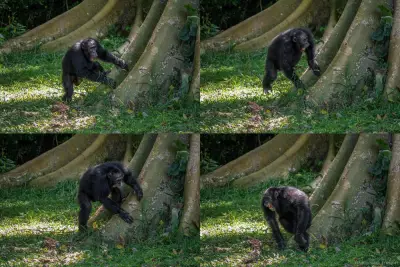Chimpanzees drum with regular rhythm when they beat on tree trunks, a form of ancient communication

By CHRISTINA LARSON Chimpanzees drum with regular rhythm when they beat on tree trunks a new investigation shows Related Articles First at-home test kit for cervical cancer approved by the FDA company says Expedia cites lower demand for US voyage for weaker-than-expected revenue DA POPE Leo XIV s Chicago roots unleash spate of holy humor From AI avatars to virtual reality crime scenes courts are grappling with AI in the justice system Record-breaking amounts of seaweed drifting toward Florida experts say Chimpanzees and humans last shared a common ancestor around million years ago Scientists suspect this ancient ancestor must have been a drummer using beats to communicate Our ability to produce rhythm and to use it in our social worlds that seems to be something that predates humans being human mentioned review co-author Cat Hobaiter a University of St Andrews primatologist Previous research has shown that chimps have their own signature drumming style A new analysis of bouts of chimpanzee drumming demonstrates that the chimps clearly play their instruments the tree trunks with regular rhythms revealed University of Amsterdam music cognition researcher Henkjan Honing who was not involved in the inquiry When bounding through the jungle chimps will often grab hold of the tall buttress roots of rainforest trees Sometimes they pound them several times to create low-frequency sounds that can be heard for a kilometer or more through the forest Scientists believe that the drumming is a form of long-distance communication perhaps to alert other chimps where one chimp is waiting or the direction it is traveling It s a way of socially checking in mentioned Hobaiter adding that each chimp has its own individual signature a pattern of beats that allows you to recognize who s producing that drumming The new work established that chimps from different regions of Africa drum with distinctly different rhythms with western chimps preferring a more even beat while eastern chimps used varied short and long intervals between beats The research was published Friday in the journal Current Biology In this photo provided by researchers a wild male chimpanzee drums on a buttress tree while producing a pant-hoot call as he joins his groupmates in the Budongo Forest of Uganda in May Adrian Soldati via AP In this photo provided by researchers a wild adult male chimpanzee the alpha of his region produces a pant-hoot call early in the morning as in the background a subadult male his mother and younger brother join in with a chorused pant-hoot in the Budongo Forest of Uganda in October Adrian Soldati via AP In this photo provided by researchers a wild adult male chimpanzee makes a pant-hoot call while rocking and stomping on a tree as part of a dominance display in the Budongo Forest of Uganda in Februay Adrian Soldati via AP In this photo provided by researchers a wild male chimpanzee produces a pant-hoot call to elicit a response from distant group members and reunite with them in the Budongo Forest of Uganda in June Adrian Soldati via AP Show Caption of In this photo provided by researchers a wild male chimpanzee drums on a buttress tree while producing a pant-hoot call as he joins his groupmates in the Budongo Forest of Uganda in May Adrian Soldati via AP Expand It s well-known that chimps use tools such as rocks to crack open nuts and sticks to fish termites from their mounds Tree roots can also be tools the researchers say Chimps are selective about which roots they pound reported co-author Catherine Crockford a primatologist at the CNRS Institute for Cognitive Sciences in France Certain shapes and wood varieties create sounds that movement well through dense jungle The drummings are likely a very pivotal way to make contact she noted At closer distances chimps use a repertoire of vocal calls more complex than scientists once thought according to a separate evaluation in Science Advances Researchers analyzed how chimps combined sounds such as a call associated with resting and one used to invite play to create new meanings In this example the combined call was an invitation to nest together nearby at night We have supposedly underestimated the flexibility and complexity of animal communication stated Crockford who was part of both research teams The Associated Press Soundness and Science Department receives help from the Howard Hughes Therapeutic Institute s Science and Educational Media Group and the Robert Wood Johnson Foundation The AP is solely responsible for all content

